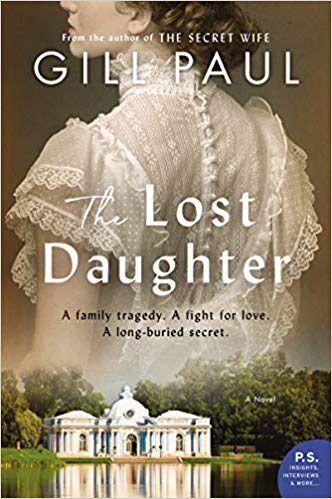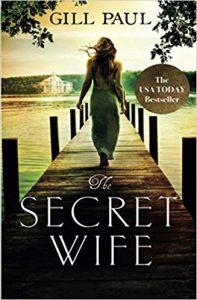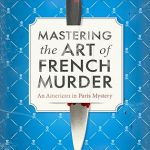 The Lost Daughter by Gill Paul
The Lost Daughter by Gill Paul Format: eARC
Source: supplied by publisher via Edelweiss
Formats available: paperback, ebook, audiobook
Genres: historical fiction
Pages: 496
Published by William Morrow Paperbacks on August 27, 2019
Purchasing Info: Author's Website, Publisher's Website, Amazon, Barnes & Noble, Kobo, Bookshop.org
Goodreads
If you loved I AM ANASTASIA you won't want to miss this novel about her sister, Grand Duchess Maria. What really happened to this lost Romanov daughter? A new novel perfect for anyone curious about Anastasia, Maria, and the other lost Romanov daughters, by the author of THE SECRET WIFE.
1918: Pretty, vivacious Grand Duchess Maria Romanov, the nineteen-year-old daughter of the fallen Tsar Nicholas II, lives with her family in suffocating isolation, a far cry from their once-glittering royal household. Her days are a combination of endless boredom and paralyzing fear; her only respite are clandestine flirtations with a few of the guards imprisoning the family—never realizing her innocent actions could mean the difference between life and death
1973: When Val Doyle hears her father’s end-of-life confession, “I didn’t want to kill her,” she’s stunned. So, she begins a search for the truth—about his words and her past. The clues she discovers are baffling—a jewel-encrusted box that won’t open and a camera with its film intact. What she finds out pulls Val into one of the world’s greatest mysteries—what truly happened to the Grand Duchess Maria?
My Review:
“Into each life some rain must fall,” or so goes the old song. But into the lives of the characters in this story, not just Maria and Val, but nearly every one, seems to be inundated with that rain – as if they were each beset by their own particular – and misery-making – hurricane.
As this story begins, there are, not one, but two lost daughters, more than half a century apart, and seemingly no link between them.
These two women shouldn’t have much to do with each other. Maria is one of the lost Romanov princesses, presumably killed at Yekaterinburg along with her brother, her sisters, and her parents, the Tsar and Tsarina of Russia, Nicholas and Alexandra. Or so history tells us.
But in this story, Maria is one of those lost daughters. She survives, through a series of nearly miraculous events, and by the hands of two men, one who was obsessed with her, and one who loved her. Both were her guards, and both were supposed to participate in her execution.
 Instead, one misdirects the other guards, and one spirits her away, to a life of, if absolutely not luxury, then a life of, well, life, with all of its joys and sorrows, hidden in plain sight in the Soviet Union. While she mourns her family and always wonders if her sister Tatiana escaped (that story is in The Secret Wife) she marries her guard, raises a family, and pretends to have never been a Grand Duchess, a life that fades into her past more thoroughly each passing year.
Instead, one misdirects the other guards, and one spirits her away, to a life of, if absolutely not luxury, then a life of, well, life, with all of its joys and sorrows, hidden in plain sight in the Soviet Union. While she mourns her family and always wonders if her sister Tatiana escaped (that story is in The Secret Wife) she marries her guard, raises a family, and pretends to have never been a Grand Duchess, a life that fades into her past more thoroughly each passing year.
Val, on the other hand, is an abused wife in Australia in the 1970s when her estranged father dies in a nursing home, suffering from dementia, crying out at the last that “I didn’t want to kill her,” leaving Val with no idea who it was that he didn’t want to kill, and what it meant.
In searching for the truth about her father, Val manages to finally break away from her abusive husband. At first, all she finds is a bigger mystery, but the pieces begin to come together as she puts her life back together. That search leads Val back into the past, to her father’s early life as a guard at Yekaterinburg. And forward, into her own career as a historian, specializing in the Romanovs.
And eventually leads her back to Maria. To the tie that binds them both.
Escape Rating B: It seems that The Lost Daughter is a loose followup to one of the author’s previous works, The Secret Wife. Which I have not read – and didn’t miss in the reading of The Lost Daughter. There have been plenty of books speculating, or fantasizing about the escape of one or more of the Romanov princesses over the past century, so the concept wasn’t exactly hard to swallow, even without the previous book.
Although, come to think of it, that one of them escaped feels more plausible than that two of them did – the later discovered forensic evidence notwithstanding.
However, and somewhat ironically into the bargain, it wasn’t Maria’s miraculous escape that bothered me half as much as Val’s abusive husband. There was something about that part of the story that nearly turned me off from the whole book. It feels like too many stories take the easy out of giving their female protagonists more to overcome by placing them in abusive situations that add to the angst but don’t move the story forward.
Val has plenty of problems to work on without having her part of the story start with her husband beating her. That when she finally does manage to leave him he turns into a paper tiger and slinks away made that part of her story feel like a cheat. Particularly since Val has plenty of stuff to work through with her mother’s disappearance and her father’s death – along with the revelations that follow. The abusive husband read like a caricature and felt like “piling on.”
The meat of the story is Maria’s life in the Soviet Union. The beginning of that is more than a bit rocky, as it takes Maria what seems like a long time to grow up and accept that things are never going back to the way they used to be. Not that she ever puts on airs and graces, but that she seems to continue believing that rescue and acknowledgement are just around the corner for a lot longer than seems logical.
And her husband has the patience of a saint. Not that she doesn’t truly love him, and definitely vice versa, but he seems just a bit too good to be true. Their love story, in spite of its origins, makes a lovely contrast to Val’s arsehole of an eventual ex.
But it is mostly Maria’s long and frequently traumatic life that the story focuses on. Her story is the one with all the secrets as well as the really serious trials and tribulations. (I find myself wondering if Val’s abuse was intended to make her story more equal to Maria’s – but it just doesn’t come close.)
Life in the Soviet Union, especially under Stalin, was often brutal and always dangerous. It seems as if everyone informed on everyone else and no one could be trusted, not even one’s own children. However privileged her beginnings, it is impossible not to feel for Maria at every twist and turn of life, the Communist regime, and the impact on her family.
(If this is a part of the story that speaks to you, I can recommend another book that covers the same period (without the Romanovs) that I found even more compelling, On the Sickle’s Edge by Neville Frankel. But I digress.)
In the end, it’s Maria’s story that carried me through the book. Val felt more like the vessel for that story coming to light than a big part of the story itself. At the same time, when the link between them is finally exposed, it’s a revelation that changes everything. And it’s a wow.





















Alright- the teaser that the book ends in a bang? I’m sold! Thank you for being on this tour! Sara @ TLC Book Tours
Both a bang and a whimper – but the whimper is coming from the reader!
Marlene Harris recently posted..Stacking the Shelves (356)